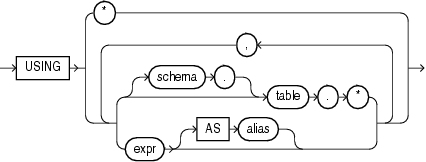| Oracle® Database SQL Language Reference 11g Release 2 (11.2) E41084-02 |
|
|
PDF · Mobi · ePub |
| Oracle® Database SQL Language Reference 11g Release 2 (11.2) E41084-02 |
|
|
PDF · Mobi · ePub |



This function is for use with classification models created by the DBMS_DATA_MINING package or with Oracle Data Miner. It is not valid with other types of models. It returns a varray of objects containing all classes in a multiclass classification scenario. The object fields are named PREDICTION, PROBABILITY, and COST. The data type of the PREDICTION field depends on the target value type used during the build of the model. The other two fields are both Oracle NUMBER. The elements are returned in the order of best prediction to worst prediction.
For bestN, specify a positive integer to restrict the returned target classes to the N having the highest probability, or lowest cost if cost matrix clause is specified. If multiple classes are tied in the Nth value, then the database still returns only N values. If you want to filter only by cutoff, specify NULL for this parameter.
For cutoff, specify a NUMBER value to restrict the returned target classes to those with a probability greater than or equal to (or a cost less than or equal to if cost matrix clause is specified) to the specified cutoff value. You can filter solely by cutoff by specifying NULL for bestN.
When you specify values for both bestN and cutoff, you restrict the returned predictions to only those that are the bestN and have a probability (or cost when the cost_matrix_clause is specified) surpassing the threshold.
The cost_matrix_clause clause is relevant for all classification models. When you specify this clause, both bestN and cutoff are treated with respect to the prediction cost, not the prediction probability. The value of bestN restricts the result to the target classes having the N best (lowest) costs, and cutoff restricts the target classes to those with a cost less than or equal to the specified cutoff.
When you specify this clause, each object in the collection is a triplet of scalar values containing the prediction value (the data type of which depends on the target value type used during model build), the prediction probability, and the prediction cost (both Oracle NUMBER).
If you omit this clause, then each object in the varray is a pair of scalars containing the prediction value and prediction probability. The data types returned are as described in the preceding paragraph.
Specify COST MODEL to indicate that the scoring should be performed by taking into account the scoring cost matrix associated with the model. If no such cost matrix exists, then the database returns an error.
Specify COST MODEL AUTO if the existence of a cost matrix is unknown. In this case:
If the stored cost matrix exists, then the result is the same as with COST MODEL.
If no stored cost matrix exists, then the result is almost the same as without the cost_matrix_clause, except the object in the collection is a triplet and the cost value is computed based on the unit cost matrix (0's on the diagonal and 1's everywhere else). This is equivalent to one minus probability for the given class. The cutoff parameter is ignored if no stored cost matrix exists.
Use the VALUES clause (the bottom branch of the cost_matrix_clause) to specify an inline cost matrix. You can use an inline cost matrix regardless of whether the model has an associated scoring cost matrix. Refer to Oracle Data Mining Application Developer's Guide for an example of an inline cost matrix
The mining_attribute_clause behaves as described for the PREDICTION function. Refer to mining_attribute_clause.
See Also:
Oracle Data Mining Concepts for detailed information about Oracle Data Mining
Oracle Data Mining Application Developer's Guide for detailed information about scoring with the Data Mining SQL functions
The following example lists, for ten customers, the likelihood and cost of using or rejecting an affinity card. This example has a binary target, but such a query is also useful in multiclass classification such as Low, Med, and High.
This example and the prerequisite data mining operations can be found in the demo file $ORACLE_HOME/rdbms/demo/dmdtdemo.sql. General information on data mining demo files is available in Oracle Data Mining Administrator's Guide. The example is presented here to illustrate the syntactic use of the function.
SELECT T.cust_id, S.prediction, S.probability, S.cost
FROM (SELECT cust_id,
PREDICTION_SET(dt_sh_clas_sample COST MODEL USING *) pset
FROM mining_data_apply_v
WHERE cust_id < 100011) T,
TABLE(T.pset) S
ORDER BY cust_id, S.prediction;
CUST_ID PREDICTION PROBABILITY COST
---------- ---------- ----------- -----
100001 0 .96682 .27
100001 1 .03318 .97
100002 0 .74038 2.08
100002 1 .25962 .74
100003 0 .90909 .73
100003 1 .09091 .91
100004 0 .90909 .73
100004 1 .09091 .91
100005 0 .27236 5.82
100005 1 .72764 .27
100006 0 1.00000 .00
100006 1 .00000 1.00
100007 0 .90909 .73
100007 1 .09091 .91
100008 0 .90909 .73
100008 1 .09091 .91
100009 0 .27236 5.82
100009 1 .72764 .27
100010 0 .80808 1.54
100010 1 .19192 .81
20 rows selected.